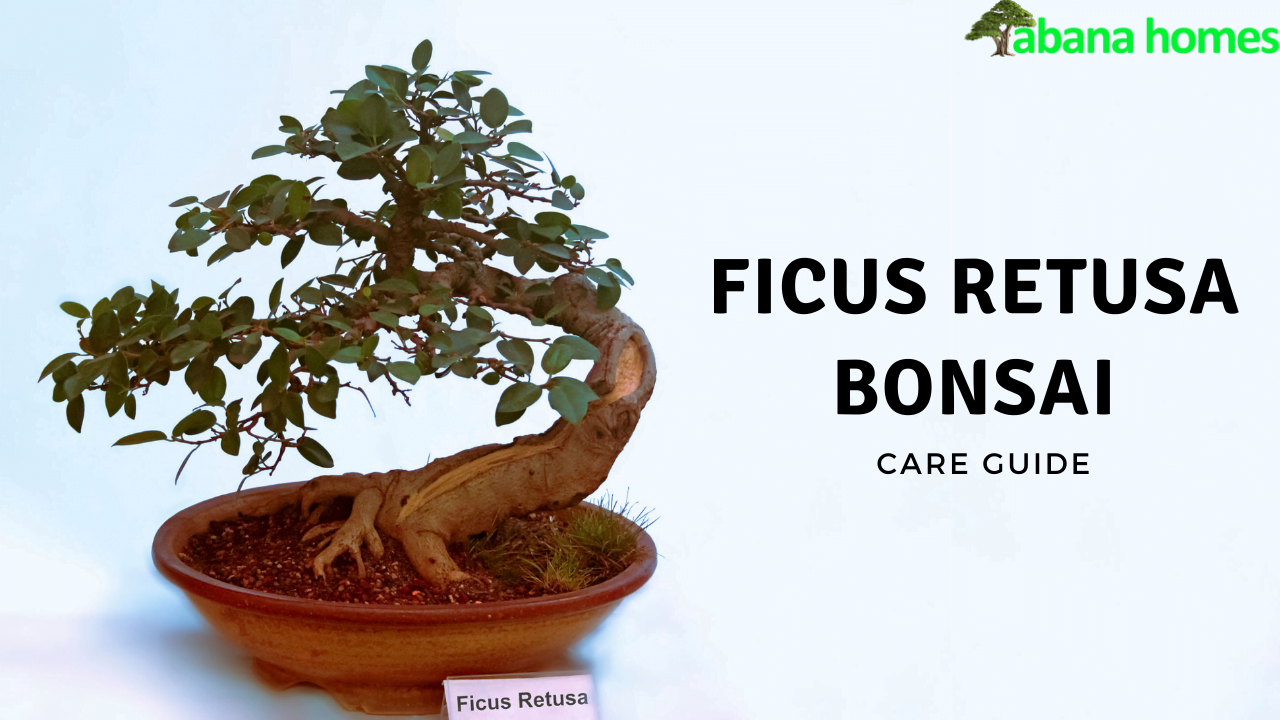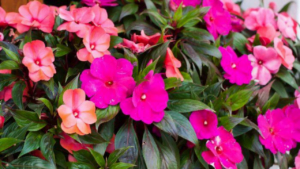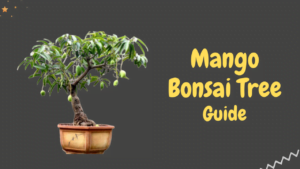Do you know ficus retusa bonsai is one of the strongest and most suitable for bonsai enthusiasts?
In this article, we will tell you about how to care for ficus retusa bonsai.
Ficus Retusa Key Facts
| Name | Ficus Retusa |
| Family | Moraceae |
| Height | 16 to 32 Inches |
| Care | Beginner-friendly |
| Exposure | Bright but indirect light |
| Watering | Moderate |
Ficus Retusa, also known as the Taiwan Ficus or Banyan Fig, is a fast-growing, spherical, broad-headed evergreen tree with a full spread. The glossy, tiny, dark-green leaves rotate along the stem and are thickly coated on big branches.
The tree produces new growth all year. Light rose to chartreuse hue, giving it a remarkable two-toned aspect. The smooth, light Grey to reddish bark is sprinkled with tiny, horizontal flecks that resemble tiger marks and securely supports the enormously spreading canopy.
It has a distinct personality due to the production of aerial roots. Because of these aerial roots, Ficus retusa bonsai spread its branches and occupied a large ground in nature. The ficus retusa bonsai care is easy, and it is one of the most tolerant, flexible, and trouble-free indoor bonsai trees.
Your bonsai will stay healthy, beautiful, and small for many years if you take excellent care. Your bonsai will grow in beauty as it matures over time because it is a small living tree.
Looking for a flowering bonsai tree for sale? Online retailers and local nurseries offer a wide variety of species and sizes to choose from. Popular flowering bonsai tree species include Azalea, Cherry Blossom, and Wisteria. However, it’s important to research the specific care requirements of your chosen tree to ensure it thrives and blooms beautifully. Enjoy the beauty and tranquility of nature with a flowering bonsai tree.
Caring for Ficus Retusa
Location
The ficus retusa bonsai care includes creating a space with appropriate light and ventilation if it is located within the house. To adequately photosynthesize, place your bonsai as close to a well-lit window as feasible.
Make sure you choose a growing place that receives full to partial sunlight and has a temperature of at least 55 degrees Fahrenheit. Keep the plant from draughts and places where the temperature fluctuates.
If the foliage appears to be dried from too much sunlight, move the ficus retusa bonsai plant to a somewhat shaded spot. When the weather dips below 55 degrees, bring the tree indoors to avoid stunted growth or death.
Note for bonsai ficus retusa care:
- The growth of our bonsai will be faster and more vigorous if you decide to place it outside. It will make the tree’s crown look larger and bushier. You must keep a check on the water requirements, as they will be higher in this case.
- A daily dose of four to six hours of sunlight should be sufficient. It’ll be even better if you can supply more
Irrigation of Ficus Retusa
There is no stable guideline because several factors will determine the irrigation frequency. Ficus retusa bonsai care depends upon the bonsai’s location, humidity, and temperature. Ficus retusa is a drought-resistant species, although it still has to be watered when the substrate is partially dry.
Ficus retusa does not require a lot of water, and it should not be irrigated too frequently.
It’s also crucial to let the soil dry up completely before watering again.
- You may need to water it a little more in the summer, especially if you plan to leave your bonsai outside.
- Your ficus retusa doesn’t adore water stagnation near the roots; therefore, avoid collecting it in a saucer or ensure to keep it dry.
When air moisture is high, Ficus retusa thrives.
- You can sprinkle the leaves several times a week with mild water during the winter.
- You can let your ficus retusa’s pot sit on a tray of clay pebbles filled with water without touching the water itself.
Note for bonsai ficus retusa care:
Reduce the amount of water you use in the fall and winter months by only watering when the soil is somewhat dry to avoid over-saturation, leading to root rot.
Defoliation
Defoliating is a method of achieving a more profuse branching pattern and smaller leaves. It entails removing the leaves from the tree to create an artificial winter and force the bonsai to sprout again. Ficus retusa bonsai care includes using this technique on mature leaves at the beginning of summer, after the initial spring sprouting.
It’s important to remember that you should only use this approach on healthy and vigorous bonsai. If your ficus retusa bonsai tree is weak, it is best to wait to strengthen so that its health does not deteriorate.
Pruning of Ficus Retusa
The ficus retusa bonsai care includes pruning to keep bonsai trees in good form. To prevent the bonsai from stress, prune it when the tree isn’t actively developing during the winter months. Once the branch has grown at least ten leaves, clip off up to four leaves at a time.
To keep the growing medium fresh, repot the ficus retusa bonsai tree every two to three years. You can retain the compact bonsai shape by pruning the roots to one-third their original size and repotting the tree in the same container.
Ficus trees react nicely to trimming if they are healthy and well-maintained. It’s a good idea to conduct some mild fertilizing beforehand.
Note for bonsai ficus retusa care:
- The end of spring is the optimal time to prune Ficus.
- You can prune them till the middle of the summer, giving them time to heal and grow back.
- Ficus produces a white milky material called latex in pruning wounds. Because it might burn the skin for many people, it is recommended that you use gloves when performing this task.
Here are some pointers on pruning a bonsai.
- Snip new branches off as they appear, either to keep the original shape or to help it evolve into the shape you want.
- You can prune your ficus bonsai in the spring, preferably on the previous year’s growth.
- Ficus retusa is a shrub that can withstand many trimming, even heavy pruning, so you can prune heavily.
Wiring
Wiring is a technique for modeling branches without going through the process of trimming. These bonsai’s tiny branches are extremely flexible. Modeling is easier as a result, but large branches are stiffer and more difficult to bend without breaking. Wiring is best done after trimming or defoliating when the structure is most visible.
Fertilization
If you want your ficus retusa bonsai tree to be healthy and beautiful, you’ll need to fertilize it. Ficus retusa bonsai care includes refilling the soil’s nutrients as they grow in a small container. Any general-purpose liquid fertilizer will suffice.
Note for bonsai ficus retusa care:
Except during the winter, you can spray fertilizer at least once a month.
Repotting
The ficus retusa bonsai care involves repotting it regularly when the root system of a bonsai has filled the pot. You should repot your bonsai to provide your tree with new soil.
Most deciduous trees need repotting every two to three years, while evergreens only need every four to five years. This method may not always be accurate as the trees grow at varying rates. You should keep a check on your tree’s root system every year to see if it has become pot-bound.
The potting process of ficus retusa bonsai tree is usually simple and safe. The ideal time to repot is Mid-summer.
- You should take out the tree of the pot and all of its soil.
- Next, remove the tree’s exterior and bottom fourth of root mass. You achieve this by raking the soil away and then cutting the roots back.
- It is not suggested to prune back more than one-fourth of a tree’s root mass in most circumstances.
- After that, you can repot the bonsai tree to its original pot or place it in a new one.
- Then, for drainage, ensure to add a thin layer of small gravel to the bottom of the pot.
- Add the new fresh dirt on top of the gravel.
- Place a layer of well-draining soil on the bonsai tree to raise it to its prior height in the pot.
- After replanting the tree in the pot, fill up the empty space left by the pruned root mass with fresh soil.
- You should push the new soil around and beneath the root in such a way that no air pockets are left.
- You should water your ficus retusa bonsai tree thoroughly after repotting.
Most Common Pests of Ficus Retusa
Ficus retusa is susceptible to scales and thrips
Scales are a type of hard-shelled insect that eats the stems and leaves of plants. Scales have a strong outer layer that makes insecticides ineffective. The ficus retusa bonsai care includes picking up and removing the scales as soon as they are noticed. Thrips eat the leaves and can defoliate them.
You will need a magnifying glass to observe them clearly; they are typically 2 mm in size in this species. The tormented leaves fold, providing a safe haven for the larvae. You have to pull out the infected leaves and use a systemic insecticide to get rid of them.
The leaves on your Ficus retusa are starting to fall off
Your Ficus retusa may be drowning in water or lacking moisture or light. It’s important to remember that putting your ficus retusa bonsai in a draughty region can result in partial or complete leaf loss. Ficus retusa bonsai care includes watering only when the soil is completely dry.
Red Spider
They are small mites. These mites puncture the leaves, causing a swarm of tiny yellow spots to form. A good acaricide is the best treatment for bonsai ficus retusa care.
Mealybugs
Cottony mealybugs release a significant amount of molasses, which fall on the Ficus retusa leaves, ferment and turn black when fermented. Cottony mealybugs are easily identified by their enormous white cotton-like filaments. In this case, ficus retusa bonsai care is a necessity.
Conclusion
Ficus retusa is one of the few tree species that can thrive indoors and outdoors. It is one of the most favored bonsai worldwide.
Because of its tiny stature and sturdy trunk, it is an excellent decorative plant for modern designer homes. The ficus retusa bonsai care is beginner-friendly.
We hope you enjoyed this complete care guide to the Ficus retusa bonsai tree.







